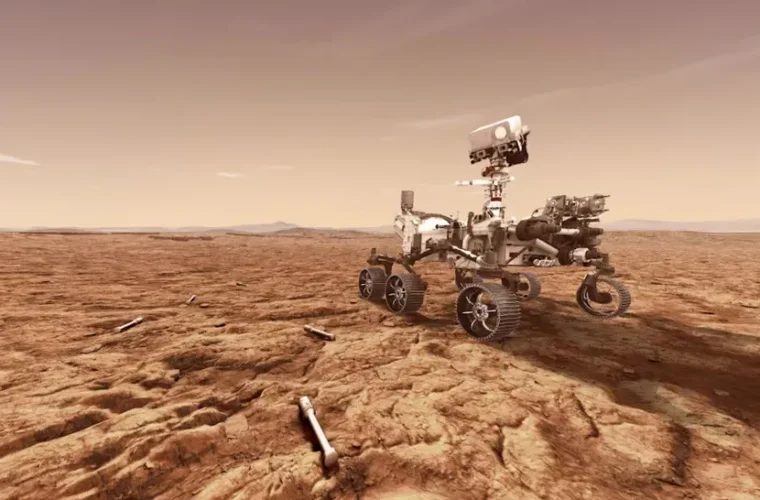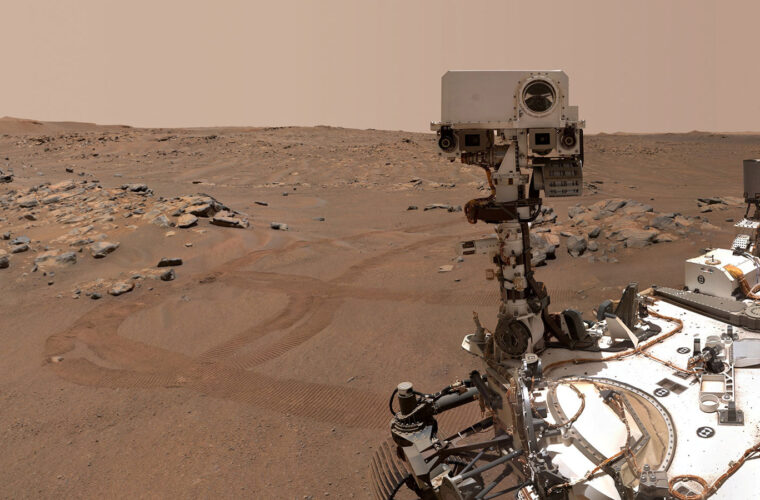NASA’s Mars 2020 mission touched down on Martian soil on February 18th. Since then, the rover Perseverance has been capturing images and the imagination as part of its ongoing reconnaissance of the planet’s rusted surface.
The Red Planet has fascinated scientists for generations. And recent discoveries are shedding light on a surprisingly active past. There are even suggestions that life might once have subsisted on the planet during its ancient history.
Iron-rich, rock-strewn, and volcano-speckled — Mars sits a mere 237 million kilometres from Earth at time of writing. The planet’s icy surface temperatures and exceptionally thin carbon dioxide atmosphere make for an unwelcoming terminus.
But investigations show that during an earlier epoch the atmosphere was thicker and retained more heat, allowing water to remain as a liquid on the planet’s surface. As a consequence, scientist now envisage Mars in the past as a windy, exotic world of lakes and rivers.
These findings are one reason that The Bringer of War is currently a destination in vogue.
As well as the United States, the United Arab Emirates and China both sent probes which arrived within days of one another. All three nations targeted a better-than-normal launch window in July last year, with Earth and Mars aligning for a shorter voyage. After seven months of travel, they each entered orbit in February.

In search of life
NASA’s latest man in the field, Perseverance is already hard at work in the Martian trenches, with an assignment to gather soil samples for a subsequent journey back to Earth for analysis. The recovery mission for samples is pencilled in for 2031.
Equipped with lasers, radar, weather analysis, a multitude of cameras, an experimental oxygen synthesiser, a robotic arm, and a novel Martian quadcopter, the rover came with a full toolkit. While it has a range of experiments to conduct, some of them precursors to future crewed Martian exploration — the primary mission is clear:
“Perseverance is the first step in bringing back rock and regolith [dust] from Mars. We don’t know what these pristine samples from Mars will tell us. But what they could tell us is monumental – including that life might have once existed beyond Earth,” says Thomas Zurbuchen, associate administrator for science at NASA.
The rover has already taken a trove of images and videos and will be using its mechanical arm for sampling. The six-wheeled nuclear-powered scientist has a two-year assignment. Its rover predecessor, Curiosity, which landed in 2012, overstayed its welcome considerably — and is still operational today.
As such, there is no saying how long Perseverance could be blazing trails over Martian terrain.
“This rover is, at its heart, a robotic geologist and a mobile astrobiologist […] We’re really going after the ability to identify which rocks might be most likely to have preserved the organic fingerprints of life in the past,” says Lori Glaze, head of NASA’s planetary science division.
When perseverance is done, humanity might finally have evidence of life beyond Earth.

The prize is enticing, but it is not for the faint of heart. Mars is exceptionally difficult to land on safely. There have been numerous missions over the years that ended in catastrophic failure.
The Red Planet’s thin atmosphere offers little resistance for slowing spacecraft during entry but is thick enough to produce heat from friction. Craft must be protected with bulky heatshields to survive piercing the atmosphere. They must also use rockets to slow themselves which means more fuel and equipment needs to be transported, complicating logistics with heavier payloads.
At the same time, the distance from Earth to Mars means that communications experience a 5- to a 20-minute delay, depending on where the planets are in their orbit of the sun. This makes real-time control of spacecraft impossible: manoeuvres must be performed autonomously by onboard computer programs.
The “seven minutes of terror” as NASA describes it, saw the Mars 2020 lander tearing through the atmosphere, making use of every avenue available to arrest its descent and ending with a complex sky-crane landing manoeuvre. The video can be seen online and makes for fascinating viewing.
“Landing on Mars is always an incredibly difficult task and we are proud to continue building on our past success,” says NASA’s jet propulsion laboratory director, Dr Michael Watkins.
“We built the rover not just to land but to find and collect the best scientific samples for return to Earth, and its incredibly complex sampling system and autonomy not only enable that mission, they set the stage for future robotic and crewed missions,” he explains.
Martian skies
The United Arab Emirates probe Hope is presently orbiting Mars as well. Its mission is to chart and chronical changes in the Martian atmosphere.
The probe is fixed in a wide elliptical orbit, allowing it to capture rich, complete data on Mars at all times and locations, once it begins its May-scheduled science phase of operations. The aim is to produce a detailed weather mapping model of the Red Planet.
The model, once complete, will be freely available to the global scientific community back home on Earth.
China’s Tianwen-1 mission actually has its own landing excursion set to touch down in May. After one more lander attempts the perilous descent, the Chinese rover will begin its mission of using radar to scan for underground water.
As the successes start stacking up, minds are turning increasingly to what comes next for Mars. The logical progression is, of course, crewed exploration of The Red Planet. And innovators are already working on how to make life on Mars, though temporary at first — liveable.
One company, AI SpaceFactory, has already built a scaled-down replica of its 3D-printed Martian habitats. The project won the first prize in a competition set up by NASA. The concept involves using local minerals found on Mars for construction materials.
The space race to conquer Mars in a tangible way is well and truly alive.



